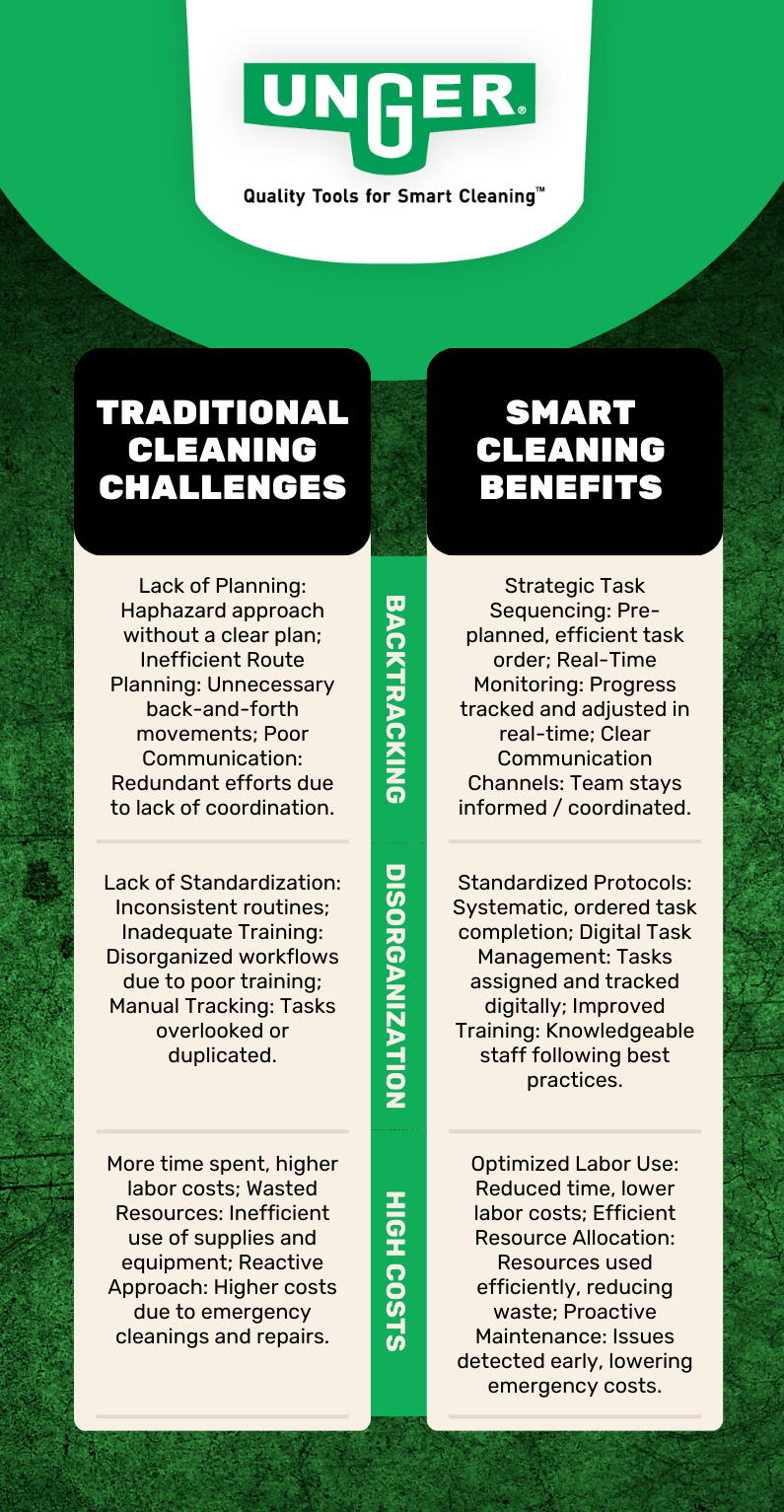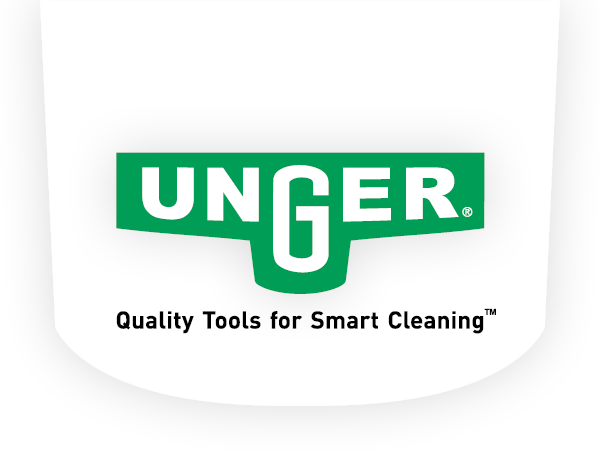NEW! Powerful Nano Filtration with Unger's HydroPower® Nano See The Product

Smart Cleaning: Minimize Backtracking, Eliminate Disorganization & Reduce Costs
In today’s cleaning industry landscape marked by staffing shortages, employee burnout, and budget constraints, facility managers and building service contractors must find innovative ways to optimize their cleaning practices. By asking critical questions like, “How are we cleaning currently, , and does it make sense given our needs?” and “Are there more efficient methods to accomplish essential tasks?” you can uncover opportunities for smarter cleaning strategies.
The concept of Smart Cleaning is a tried and true concept that is still relevant today and one that we refer to as ‘smarter cleaning.’ Smart Cleaning involves a systematic approach that begins with a thorough assessment of your building’s cleaning services. This evaluation helps identify which tasks are crucial, which are important but not critical, and where you can cut back without compromising the facility’s commitment to health and safety. Armed with this analysis, you can then develop a plan aligned with the four principles of smart cleaning.
Training your staff to follow a new smart cleaning-based plan ensures that they perform tasks in a systematic and synchronized manner. This approach can, for example, enable your team to achieve in 8 hours what might traditionally take 10 or more. By adopting the concept of smart cleaning, you streamline cleaning operations, enhance efficiency, and ultimately reduce your costs.
The Key Principles of Smart Cleaning
Smart Cleaning relies on four major principles to accomplish cleaning tasks:
1. Strategic Planning and Scheduling
This first principle involves mapping out cleaning tasks in a logical order, determining the most efficient routes, and setting clear timelines for execution. The goal is to complete every task as efficiently as possible, reducing the likelihood of missed areas or backtracking.
2. Zoning and Task Segmentation
Spaces are divided into zones, and specific tasks are assigned to each zone. This segmentation allows for systematic cleaning, where each area is addressed thoroughly before moving on to the next. Best practices for inclusion: moving from top to bottom in a room and moving through a space in a circular pattern.
3. Real-Time Monitoring and Adjustment
Using technology (i.e., cleaning management software or apps) enables real-time monitoring of your staff’s progress. Supervisors can track tasks as the team completes them, make necessary adjustments to avoid backtracking, and quickly address issues that may arise, ensuring that cleaning tasks and the timeline stay on track.
4. Data-Driven Decision Making
Smart cleaning leverages data analytics to optimize cleaning processes. By analyzing data from past activities, such as the time allocated to each task and the frequency of performing certain tasks, you can minimize the inefficiencies and optimize cleaning schedules moving forward. With data in hand, you can make more informed and accurate decisions about staffing, resource allocation, and scheduling.
Challenges of Traditional Cleaning Methods vs. Cleaning Smarter
Smart cleaning transforms the cleaning process by addressing the inefficiencies of traditional methods.

Steps to Implement Smarter Cleaning in Your Operations
Step #1: Assess Your Current Cleaning Practices
A cleaning audit is a structured review process designed to evaluate the effectiveness and compliance of cleaning procedures within a facility. Its main objective is to ensure that the facility’s cleaning standards meet or exceed industry benchmarks for hygiene and safety, but the audit can also uncover areas of opportunity for reducing costs and improving efficiencies.
When conducting a cleaning audit, you’ll want to evaluate the following areas for the most comprehensive results: Efficiency and Planning; Organization and Standardization; Communication and Coordination; Resource Management; Cost and Labor; Technology Utilization; Quality and Outcomes; and Adaptability and Improvement.
Step #2: Select the Right Tools and Technologies
Complementing your processes with cleaning management software can help optimize task scheduling and tracking, especially with digital checklists that enable easy updates, monitoring, and reporting. You can also consider utilizing mobile apps, such as CleanTelligent/Otuvy, Swept and SmartInspect, that allow cleaning teams to communicate in real-timereport issues, and receive updates, ensuring everyone is on the same page. Check out this article on what to consider when evaluating cleaning management tools.
As for the commercial cleaning tools to support your smart cleaning approach, the most important factor is ensuring that all necessary equipment and supplies are readily available to prevent workers from making unnecessary trips back to the janitor closet. A well-organized janitor cart is essential and should include frequently used items front and center for easy access, such as dusters, microfiber cleaning clothes and dustpans. In selecting equipment, opt for tools that prioritize speed; for example, opt for lightweight, ergonomic cleaning tools that ease the workload and allow for faster, more efficient cleaning.
Step #3: Train Your Staff
You’ll need to provide comprehensive instructions, clear performance goals, and demonstrate the correct cleaning techniques. During training, encourage staff to practice their specific jobs to assess their understanding and identify any knowledge gaps. Post-training, providing a role-based reference card highlighting proper methods will better ensure consistency and accuracy until they master the necessary skills, equipment handling, and cleaning processes.
Step #4: Monitor, Evaluate, and Optimize
This step entails collecting real-time data through sensors and IoT (Internet of Things) devices to monitor cleaning activities, facility usage, and environmental conditions. For example, monitoring indoor air quality (e.g., levels of CO2, humidity, dust, or pollutants) to adjust cleaning schedules accordingly, if needed.
The data is analyzed to evaluate the performance of cleaning operations, assess cleanliness levels, and incorporate feedback to identify gaps and inefficiencies. You can use these insights to optimize cleaning processes by adjusting schedules, implementing smart technology, and establishing continuous improvement practices.
Cleaning Smarter, Faster and Safer
Adopting smarter cleaning principles can transform your facility’s maintenance routines by minimizing backtracking, eliminating disorganization, and reducing overall costs. By strategically planning tasks, utilizing real-time monitoring, and making data-driven decisions, you can create a more efficient and effective cleaning process that addresses the shortcomings of traditional methods.
If we can help you source cleaning equipment that supports your smart cleaning goals, please contact us to discuss how our innovative tools help facilities clean smarter, faster and safer.

